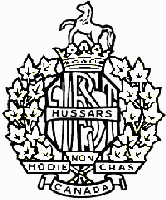
-Crest of the 1st Hussars
Hodie Non Cras
(Today not Tomorrow)
HQ: London, Ontario
Abbreviation: 1H

-Crest of the 1st Hussars
Hodie Non Cras
(Today not Tomorrow)
HQ: London, Ontario
Abbreviation: 1H
WW2 Battle Honours:
Normandy Landing
Putot-en-Bessin
Le Mesnil-Patry
Caen
The Orne
Bourgébus ridge
Faubourg de Vaucelles
Verrières Ridge - Tilly la Campagne
Falaise
Falaise Road
Quesnay Wood
The Laison
Chambois
Calais, 1944
The Lower Maas
The Rhineland
The Hochwald
Apeldoorn
Bad Zwischenahn
North-West Europe, 1944-1945
Commanding Officers:
Active Unit:
?? 38 - 3 Nov. 40: Lt-Col. T. Sanderson,
ED
4 Nov. 40 - ?? Jan. 41: Lt-Col. A.C. Spencer,
ED
?? Jan. 41 - Jan. 9 43: Lt-Col. R.H.F. Back,
ED
10 Jan. 43 - ?? May 43: Maj. F.W.K. Bingham (acting
CO)
?? May 43 - 15 Jun. 43: Maj. J.S. Duncan (acting
CO)
15 Jun. 43 - 23 Aug. 23: Lt-Col. R.H.F. Back,
ED
24 Aug. 43 - 15 Aug. 44: Lt-Col. R.J. Colwell,
DSO, ED
16 Aug. 44 - 2 Jan. 45: Lt-Col. F.E. White, DSO
3 Jan. 45 - ?? 46 Maj. W.D. Brooks, DSO, ED
Organizational History:
1 September, 1939: The regiment was mobilized
"1st Hussars, CASF'.
1 March, 1940: One squadron plus HQ squadron,
along with one squadron each from 'Lord Strathcona's Horse' and 'The Royal
Canadian Dragoons', formed the '1st Canadian Cavalry Regiment (Mechanized),
CASF'.
?? January, 1941: '1st Canadian Cavalry Regiment
(Mechanized), CASF' is disbanded, and its elements returned to their respective
regiments. The 1st Hussars is converted into an armoured regiment.
11 February, 1941: Regiment is renamed '6th Army
Tank Regiment (1st Hussars)', and assigned to 1st Canadian Armoured Brigade,
part of 1st Canadian Armoured Division (division was later renamed 5th
Canadian Armoured Division).
15 January, 1943: Regiment assigned to 3rd Canadian
Army Tank Brigade (brigade later renamed 2nd Canadian Armoured Brigade).
?? July, 1943: Renamed '6th Armoured Regiment
(1st Hussars)'.
6 June, 1944: Attached to 7th Canadian Infantry
Brigade.
12 July, 1944: u/c of 2nd Canadian Infantry Division.
17 July, 1944: u/c of 3rd Canadian Infantry Division.
20 July, 1944: u/c of 2nd Canadian Infantry Division.
17 August, 1944: u/c of 4th Canadian Armoured
Division.
20 August, 1944: u/c of 2nd Canadian Corps.
15 September, 1944: u/c of 3rd Canadian Infantry
Division.
11 October, 1944: Attached to 56th British Infantry
Brigade (49th British Infantry Division).
8 November, 1944: u/c of 2nd Canadian Infantry
Division.
6 April, 1945: u/c of 1st Canadian Infantry Division.
31 January, 1946: The active battalion was disbanded.
Operational History:
Early History
The history of the 1st Hussars regiment, dates
back to 1856, with the formation of the 1st London Volunteer troop of Cavalry,
later renamed 1st Regiment of Cavalry. In 1892, the regiment became the
1st Hussars. The regiment provided volunteers for the Canadian force sent
to South Africa during 1899-1902. During the First World War, the regiment
provided many men for the 7th Canadian Mounted Rifles, which was later
known as the 1st (Canadian) Hussars. The regiment also formed B squadron
of the Canadian Light Horse cavalry regiment, and fought in both the mounted
and un-mounted roles until the end of the war.
WW2
With the outbreak of WW2, the 1st Hussars were
mobilized on 1 September, 1939, and performed various local protection
duties until 1 March, 1940, when it helped form the 1st Canadian Cavalry
Regiment (Mechanized). Later, this unit was disbanded, and the 1st Hussars
were converted into an armoured regiment. On 13 November, 1941, the regiment
embarked for Britain, and trained there until 6 June, 1944, when it landed
in Normandy in support of the 7th Canadian Infantry Brigade. The regiment
fought throughout the Normandy campaign in the infantry support role, and
helped to close the Falaise Gap. In support of 3rd Canadian Infantry Division,
it captured the channel port of Calais, silencing the German cross channel
guns. During the winter of 44-45, the regiment performed defensive duties
with 2nd Canadian Infantry Division and 49th British (West Riding) Division
along the Maas river in central Holland. Offensive operations resumed with
the clearing of the Hochwald. With the arrival in NW-Europe of 1st Canadian
Corps in April 45, the regiment supported 1st Canadian Division in its
attacks towards Apeldoorn, which resulted in cutting off +80,000 German
troops. The last major actions fought by the 1st Hussars during the war
came in late April 45, when an ad-hoc force (Frank Force) captured Godensholt
in Germany, to relieve pressure on 4th Canadian Armoured Division. A 6th
(Reserve) Armoured Regiment (1st Hussars) served in the Reserve Army to
provide replacements for the active unit.
WW2 Casualties:
Fatal:
19 Officers
152 Other Ranks
13 MIA
Links to 1st Hussars websites:
1st Hussars
- Official website
6th
Armoured Regiment (1st Hussars) - 1st Hussars page on the Steel Chariots
site.
Honour
Roll of the First Hussars - A list of those who gave their lives with
the 1st Hussars